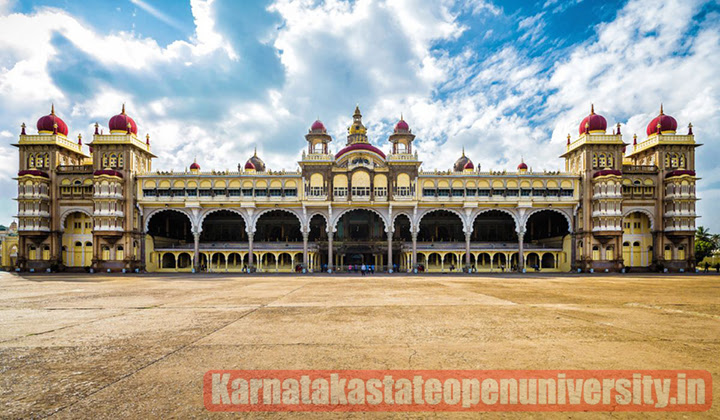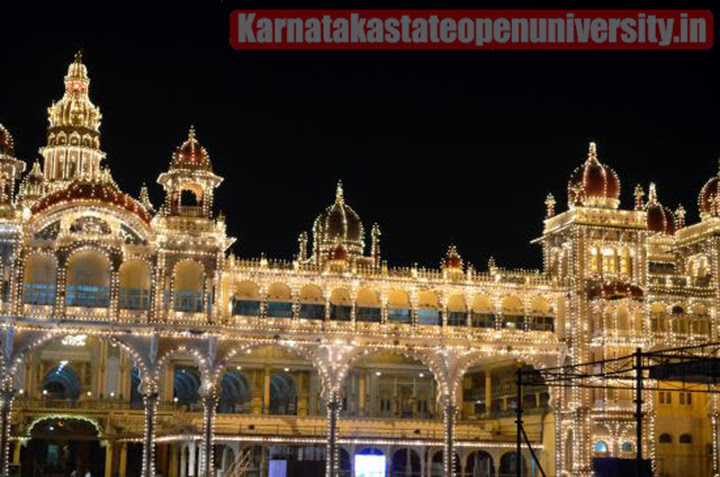Mysore Palace – A historical palace and royal residence (house), the Mysore Palace is also known as Amba Vilas Palace. It is situate in Karnataka’s Mysore. It was the seat of the Kingdom of Mysore and the Wadiyar dynasty’s official residence. The palace is in the center of Mysore and looks east toward the Chamundi Hills. Mysore is known as the “City of Palaces,” and this palace is one of seven in the city. However, the new fort’s Mysore Palace is specifically refer to.
In 1897, during the wedding of Jayalakshammanni, Chamaraja Wodeyar’s eldest daughter, the original wood-built palace burn down. It was rebuild in 1912 for Rs.42 lakhs. The current Palace is made with an Indo-Saracenic style that incorporates Hindu, Muslim, Rajput, Gothic, and other architectural styles. It is a stone building with three stories, marble domes, and a five-story tower that is 145 feet tall. An impressive sculpture of Gajalakshmi, the goddess of wealth, prosperity, good fortune, and abundance, with her elephants can be found above the central arch. A large garden surrounds the palace. The palace, which was design by Henry Irwin, a well-known British architect, is a treasure trove of exquisite artwork and carvings from around the world.
Mysore Palace
Mysore Royal residence is an extremely valuable irreplaceable asset and the pride of a realm, the Mysore Maharaja Castle is the seat of the renowned Wodeyar Maharajas of Mysore. The Wodeyars’ former possessions, including paintings, jewelry, royal attire, and souvenirs, are now house in a museum in the palace. Stained glass and mirrors abound in this kaleidoscope. The elegantly embellished and unpredictably cut entryways open into richly finished rooms. Costumes, musical instruments, toys for kids, and a lot of portraits are on display on the ground floor, which also has a courtyard that is enclose. A small assortment of weapons can be found on the upper floor.
A feast for the eyes are the magnificent columned Durbar Hall, the solid silver doors, the white marble floors, and the beautifully carved mahogany ceilings. The palace is a treasure trove of world-class artwork and exquisite carvings. Doors with exquisite carvings lead to rooms that are stunningly opulent. An open balcony with massive circular columns supports the Amba Vilas Palace’s front.

Mysore Palace Details
| Article for | Mysore Palace Karnataka History, Timing, Entry Fees, Architecture All you need to Know In 2024 |
| Mysore Palace Karnataka History, Timing, Entry Fees, Architecture All you need to Know In 2024 | Click Here |
| Category | Travel |
| Official website | Click Here |
click here:- Neemrana Fort Palace All you need to Know In 2024
While it retains its status as the Royal Seat of the Maharajas of Mysore, Mysore Palace is currently manage by the Government of Karnataka. The grand structure houses souvenirs, jewelry, royal costumes, paintings, and other valuable Wodeyar possessions. Even though the palace is open to the public, a portion of it is still home to the royal family. The Residential Museum is another museum house within the walled complex that includes some of these living quarters. It’s not surprising that the palace is one of Mysore’s most popular historical attractions.
In all of its splendor, the Mysore Dasara Festival is celebrate here. Over 6 million people visit this magnificent monument annually to learn about its long history. In addition to the structure’s grandeur, the evening illumination and light show draw a significant crowd.
History of Mysore Palace
This royal structure is the most magnificent of the seven palaces that dot Mysore’s landscape. The Wodeyars or Wadiyars, Mysore’s royal family, laid the foundation for the palace in the 14th century. During the time that Yaduraya Wodeyar ruled the Mysore Kingdom for the first time, it is believe that he construct a palace in Puragiri, also known as the Old Fort. Over the course of six centuries, this palace, which is thought to be the predecessor of the current palace, has undergone numerous demolitions and reconstructions.
The palace was originally a wooden fortress that was destroy by lightning in 1638 and rebuilt by Kantirava Narasa Raja Wodeyar. When Tipu Sultan took control of the Wodeyar Dynasty in 1793 AD, he tore down the palace and rebuilt it. Krishnaraja Wodeyar III redesigned the palace in accordance with the Hindu architectural style in 1799, shortly after Tipu Sultan’s death.
Sadly, the palace was destroy by fire in 1897 while Princess Jayalakshmmanni was getting married. The decision to rebuild the palace was made once more by Maharani Kempananjammanni Devi and her son, Maharaja Krishnaraja Wodeyar IV. British architect Henry Irwin was given the task of renovating the palace, which he complete in 1912 at a staggering cost of over 41 lakh Indian rupees. Under Jayachamarajendra Wadiyar’s rule in the 1930s, the palace underwent additional expansions and the addition of a Public Durbar Hall wing.
Architecture
The Indo-Saracenic architecture of Mysore Palace incorporates elements of Hindu, Mughal, Rajput, Gothic, and other architectural styles. Fine grey granite was use to construct the three-story palace and the 145-foot, five-story tower, while deep pink marble was use to construct the domes. This magnificent structure has two durbar halls, numerous arches, canopies, columns, and bay windows on its exterior. The palace is also surround by a vast green garden. The interiors are lavishly decorate with Czechoslovakian chandeliers, stain glass ceilings, glittering glazed flooring tiles, carve doors, and international art. The palace’s rooms are all quite enticing and stunningly extravagant.
A divine sculpture of Gajalakshmi, the goddess of wealth, with two elephants can be found above the central arch. The palace has a number of secret tunnels in addition to the three entrances on the eastern, southern, and western sides. The palace also contains a collection of temples that were made between the 14th and 20th centuries. Things to See in Mysore Palace
There is a fascinating array of things to see in and around Mysore Palace Karnataka, each of which testifies to the wealth and grandeur of the Kingdom of Mysore palace.
The top things to see in Mysore Palace include this:
- The Gombe Thotti or Doll’s Pavilion, a collection of traditional dolls in Mysore
- Golden Howdah, the Maharaja’s elephant seat made of 85 kilograms of gold
- Kalyana Mantap or Marriage Pavilion, an octagonal shaped hall with stain glass ceiling
- Public Durbar Hall, a large hall from where the Maharajas use to address the public society
- Ambavilasa, a beautifully design hall which was use by the Maharajas for their private audience on
- Elephant Gate or Ane Bagilu, the brass gate which that serves as the main entrance to the palace
- Paintings of Dasara Procession in Mysore
- Portrait Gallery, a collection of valuable paintings and photographs of the Royal Family’s
- Casket Room containing royal collections in this palace
- Wrestling Courtyard in palace
- Temples inside the Mysore palace
Mysore Palace Light and Sound Show
The light and sound show held in the evenings is one of the prime attractions at Mysore Palace, Karnataka. The entire show portrays the 600-year-old cultural heritage, history, and traditions of the Wodeyar Dynasty in a visually appealing manners.
- Duration: 45 minutes
- Timings: 7.00 pm to 08.00 pm; all days except Sundays and public holidays
- Tickets: Rs 70 for adults; Rs 30 for kids above 7 years and below 12 years

check:- Chitradurga Fort Karnataka All you need to Know In 2024
Mysore Palace Timings and Illumination
Mysore Palace is lit up in the evening on Sundays and public holidays, and also during the ten days of Dashara celebrations in Mysore. During weekdays, you can enjoy the illumination after the light and sound show for five minutes only. The illumination is done using 97000 electric bulbs, making the palace a sight to behold.
Timings
Sundays, public holidays, and during Dasara – 7:00 pm to 7:45 pm
Weekdays – 7:40 pm to 7:45 pm
Charges
Adults (Indian / Foreign) Rs. 100
Children between 10 – 18 Years: Rs. 50
Children below 10 years: Free Entrance
Tickets are sale at the southern gate and northern gate of the Mysore Palace.
Near Mysore Palace
- Dodda Gadiyaara (260m)
- Badsha Bazaar – the silk route (800m)
- Jaganmohan Palace Art Gallery And Auditorium (900m)
- Devaraja Market (950m)
- Sri Chamarajendra Zoological Gardens (1.5km)
- Karanji Lake (2.3km)
- Philomena church (2.1km)
- Mysore Railway Museum (3.5km)
- Jayalakshmi Vilas Complex Museum (4.4km)
Best time to visit
The best time to visit the palace is around the time of Dussehra when the entire compound is beautifully decorate and lights, illuminated in a golden hue.
Reviews
The Mysore Palace, designed by English architect Henry Irwin, dominates Mysore’s skyline. The palace is a three-story Indo-Saracenic structure that was build between 1897 and 1911. At its cardinal points, it has square towers that are cover in domes and are beautifully design. The Wodeyars or Wadiyars, Mysore’s royal family, laid the foundation for the palace in the 14th century. During the time that Yaduraya Wodeyar rule the Mysore Kingdom for the first time, it is believe that he constructed a palace in Puragiri, also known as the Old Fort.
The Mysore Palace has a long and interesting history. From 1350 to 1950, it serve as the Mysore royal Wadiyar family’s home for nearly 600 years. The palace had been build and rebuilt numerous times during its lifetime. After a wooden palace burn down during a wedding in 1897, Krishna Rajendra Wadiyar IV, the ruler of Mysore at the time, ordered its restoration and reconstruction. British architect Lord Henry Irwin was task with rebuilding the older palace that had been destroy by fire in 1897. The palace’s construction, which cost an exorbitant INR 41,47,913 at the time, was finish in 1912.
Related Posts:-
Red Fort Delhi All you need to Know In 2024
Agra Fort: Agra All you need to Know In 2024
Chittorgarh Fort: A epic tale of love, courage and Sacrifices All about History In 2024

